Module 8: Developing World Libraries / Mobile devices
 |
| image from dreamtime.com |
 |
| image taken Abbotsford, B.C. November 1, 2020 |
In saying this, students need access to devices to be able to maneuver the changing technologies that rules school and everyday life. The opportunity to use different devices: smartphones, laptops, tablets; the better! Not only does the technology support collaboration between students, teachers, classrooms local and global, and home, it can provide rich online resources like online libraries, educational videos, and museums. Experts and expert material is available to all learners with the help of technology.
Visit the British Museum here --> https://www.britishmuseum.org/collection
 |
| image from visitlondon.com |
 |
| image from bitmoji.com |
 |
| image from pinclipart.com |
You can visit the World Digital library here --> World Digital Library. WDL is operated by UNESCO and the US. Library of Congress and sports manuscripts, maps, photographs, rare books, and other cultural documents from as far back as 8,000 BCE. You can follow them on Twitter @WDLorg. Having the opportunity to bring these authentic invaluable pieces of human history within a click to your classroom is efficient on time, money, and resources. As long as there is one piece of technology in the classroom, students despite socio-economic status and access to devices can participate in learning.
 |
| image from onebillion.org |
https://onebillion.org/impact/partners-and-projects/
Onebillion.org is a UK non-profit organization that creates software globally that is made to bring technology into the hands of children.
One tab is a created tablet that delivers learning: reading, writing, and numeracy activities to children in their own language. Onecourse also uses tablets for children in developing nations to play activities, games, and read stories through a structure literacy and numeracy course. I truly recommend readers to take the time to visit their website and see the impactful work they are doing.
 |
| image from onebillion.org |
 |
| image from bitmoji.com |
This is not to say that the global community should stop making efforts to put physical texts in the hands of children to provide them with equal opportunity to learn how to read. 22 years ago, John Wood, a Microsoft executive visited Nepal and was affected by the state of school libraries. He left his tech job and founded Room to Read. You can read up more here as well --> John Wood's story. "During its seven-year existence, the organization has opened nearly 5,000 school libraries and about 400 schools, donated more than 1.4 million English-language books, published 146 local-language titles, and touched the lives of roughly 1.5 million students in developing countries" (Bernard, 2008).
 |
| image from bitmoji.com |
At my own school level, University of the Fraser Valley human kinetics students volunteer their time to help with teaching PE, put in volunteer hours teaching activities, and supporting our annual Sports Day events. They also collect books from our school to send to Antigua schools.
Do we need 1:1 at our schools? Do educators need to be experts of each app/device platform? https://theconversation.com/ten-reasons-teachers-can-struggle-to-use-technology-in-the-classroom-101114 My personal feeling is that there is not enough opportunity for in-service when districts introduce new platforms. The expectation is that teachers use their own time. As we are discovering, PLNS are necessary to further deep understanding of concepts and it does not happen independently. I am not a "digital native" and I am learning as I go. I am having great difficulty trouble shooting programs like MBP, Mathletics, and Teams when I myself am no expert. Then there is the inconsistency of workability with wi-fi at school, differences in technology at home, and devices working in proper order when needed.
In order to continue to support 21st century learning, there needs to be at least one opportunity to provide as many ways to connect students to the world and collaborate with families and stakeholders to bring the information to the student. This means putting in the footwork of finding grants, communicating with administrators, PAC, and community businesses to find funding to support this.
 |
| image from pbs.org |
Works Cited
Bernard, S. (2008, January 12). Room to Read: Building Libraries, Schools, and Computer Labs in Developing Countries. Retrieved October 31, 2020, from https://www.edutopia.org/global-education-libraries-developing-countries
Brendon Hyndman Senior Lecturer and Course Director of Postgraduate Studies in Education. (2020, February 13). Ten reasons teachers can struggle to use technology in the classroom. Retrieved October 25, 2020, from https://theconversation.com/ten-reasons-teachers-can-struggle-to-use-technology-in-the-classroom-101114
Children. (n.d.). Retrieved November 01, 2020, from https://onebillion.org/impact/partners-and-projects/































